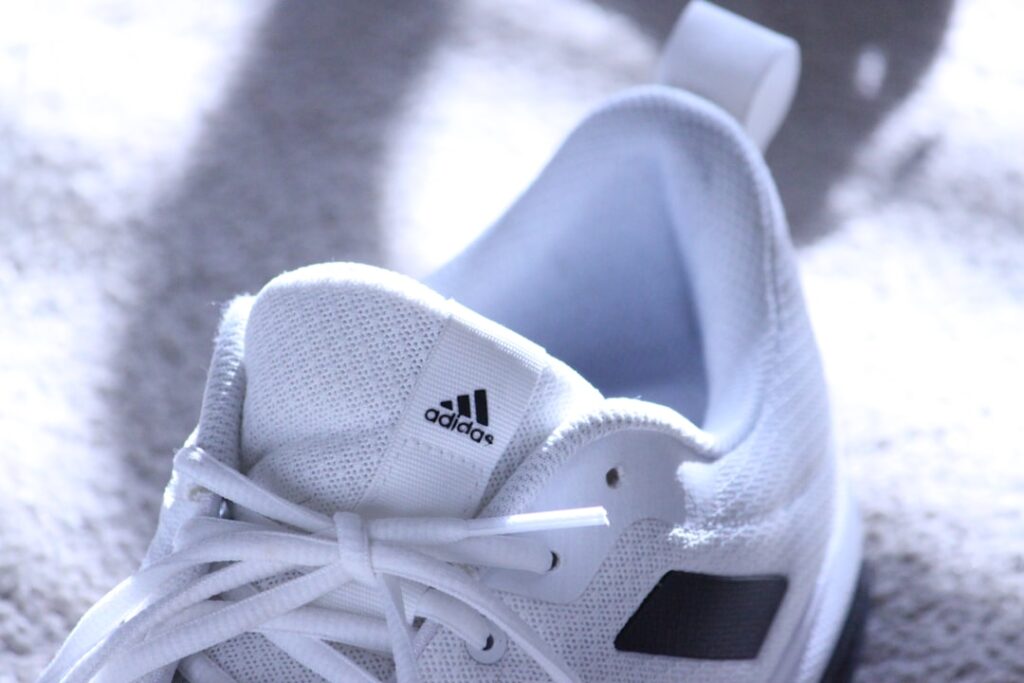The Timeless Appeal of Sambas: More Than Just Sneakers
Sambas are one of the most iconic sneaker designs in history, with over 35 million pairs sold since their 1950 introduction. Originally designed as football training shoes for icy winter pitches, they’ve evolved into a versatile lifestyle staple worn by athletes, musicians, fashion enthusiasts, and everyday people.
Quick Facts About Sambas:
- Origin: Created in the late 1940s by Adi Dassler, debuted at the 1950 FIFA World Cup
- Design: Features leather upper, suede T-toe overlay, and distinctive gum rubber sole
- Price Range: $75-$150 depending on model and materials
- Popular Variants: Samba OG, Samba Classic, Velosamba (cycling), Sambarose
- Key Features: Lightweight, durable, water-resistant, minimal cushioning
What makes Sambas stand out is their remarkable versatility. They transition seamlessly from sports to casual wear, pairing equally well with jeans, chinos, skirts, or dresses. Their simple, clean design has remained largely unchanged for over 70 years, proving that true style endures beyond fleeting trends.
The Samba’s recent resurgence in popularity has been fueled by high-profile collaborations with designers like Grace Wales Bonner and appearances on celebrities from Kendall Jenner to Rishi Sunak. For the environmentally conscious, newer Samba models include vegan options made with plant-based, sustainable materials.
Whether you’re looking for a reliable everyday sneaker, a sports shoe with heritage, or a fashion statement with cultural cachet, Sambas deliver with their understated cool and proven performance.
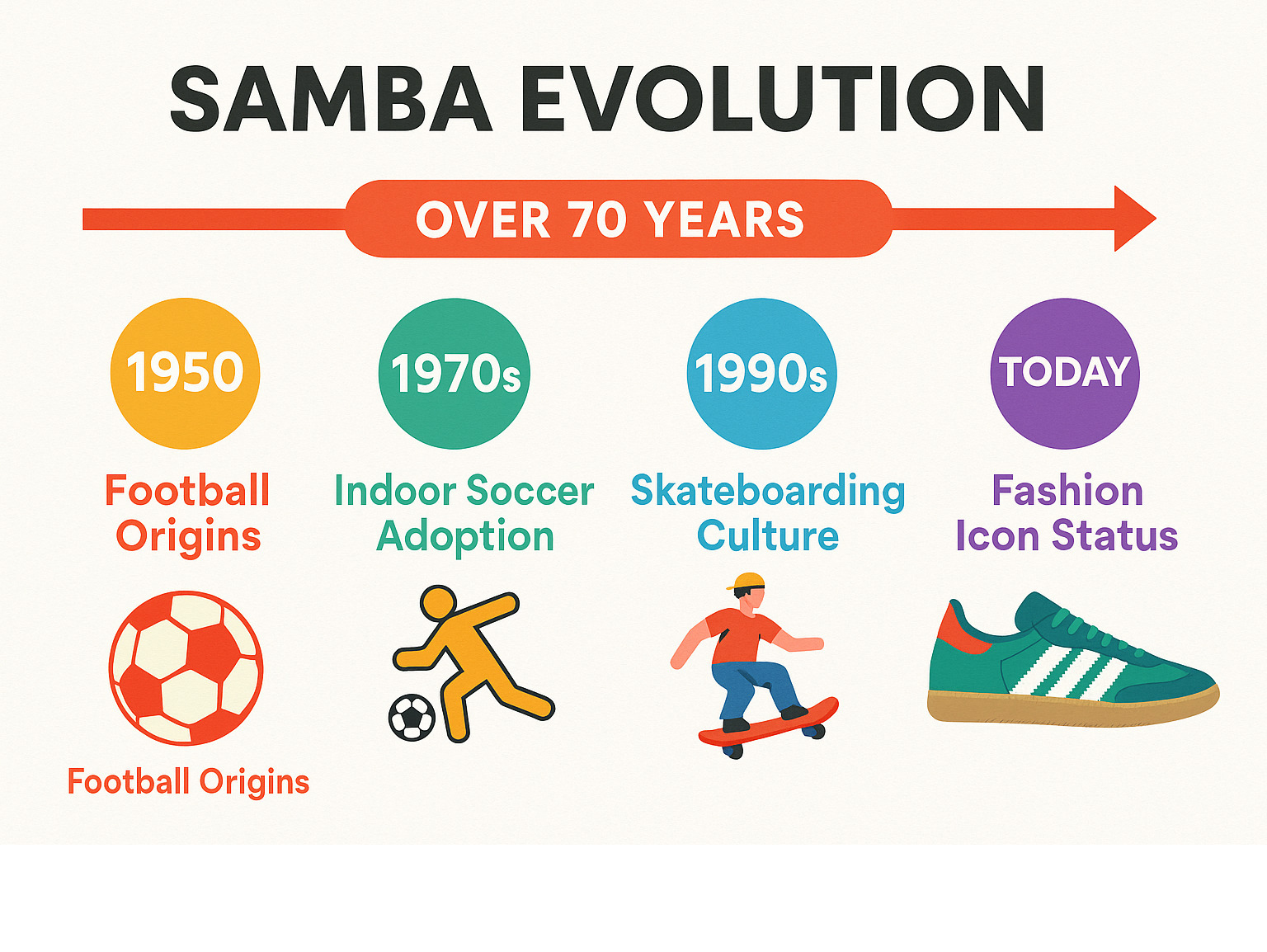
Learn more about sambas:
The Origin Story: From Frozen Pitches to Fashion Capitals
The journey of the Sambas begins in post-World War II Germany, where Adi Dassler was crafting footwear solutions that would change sports forever. While tinkering in his workshop in the late 1940s, Dassler identified a genuine problem: football players struggling to maintain footing on frozen European pitches during harsh winter months.
His solution became the original Sambas, which debuted at the 1950 FIFA World Cup in Brazil. These featured three cleverly designed cut-out suction cups on the outsole that provided unprecedented grip on icy surfaces. Dassler chose premium kangaroo leather for the upper, prized for its softness, natural water resistance and durability. The distinctive gum rubber sole delivered the traction players desperately needed.
What nobody expected was how the Sambas would transcend their original purpose. Players quickly found these shoes performed brilliantly on indoor courts too. The non-marking gum rubber outsole meant athletes could seamlessly transition from muddy fields to polished gymnasium floors without changing footwear.
This remarkable adaptability helped the Sambas achieve something extraordinary: becoming Adidas’ second most popular model ever, with over 35 million pairs sold worldwide. Even more impressive, they’ve earned the distinction of being the brand’s oldest continuously produced model, remaining in production for more than 65 years.
Key Historical Moments for Sambas
The evolution of the Sambas reads like chapters in a beloved book, with several defining moments:
The 1970s brought the Samba Originals with an improved 3-zone profile and improved ankle and heel padding—perfectly timed for the booming indoor soccer scene that was capturing America’s attention.
By 1982, the Samba Spezial arrived, featuring a shock-absorbing wedge and specialized multi-stud outsole that expanded the shoe’s versatility beyond indoor courts back to outdoor play.
The 1990s witnessed an unexpected adoption as skateboarders found the Sambas’ perfect combination of durability, excellent board feel, and that grippy gum sole—bringing these shoes into alternative youth cultures and street style.
The cultural connection deepened in the late 1990s and early 2000s when Sambas appeared in cult films like “Trainspotting,” cementing their relationship with post-punk and Britpop music scenes. These weren’t just shoes anymore—they were cultural signifiers.
The 2020s have seen perhaps the most surprising chapter yet, with designer Grace Wales Bonner’s collaboration reportedly increasing demand for the Samba OG tenfold, changing this humble athletic shoe into a coveted high-fashion statement piece.
Sambas Design & Evolution
The magic of the Samba lies in how little its core design has changed over 70+ years. This isn’t a shoe that needed constant reinvention—it got things right from the start. That said, Adidas has carefully refined and expanded the Samba family over the decades, keeping it fresh while honoring its heritage.
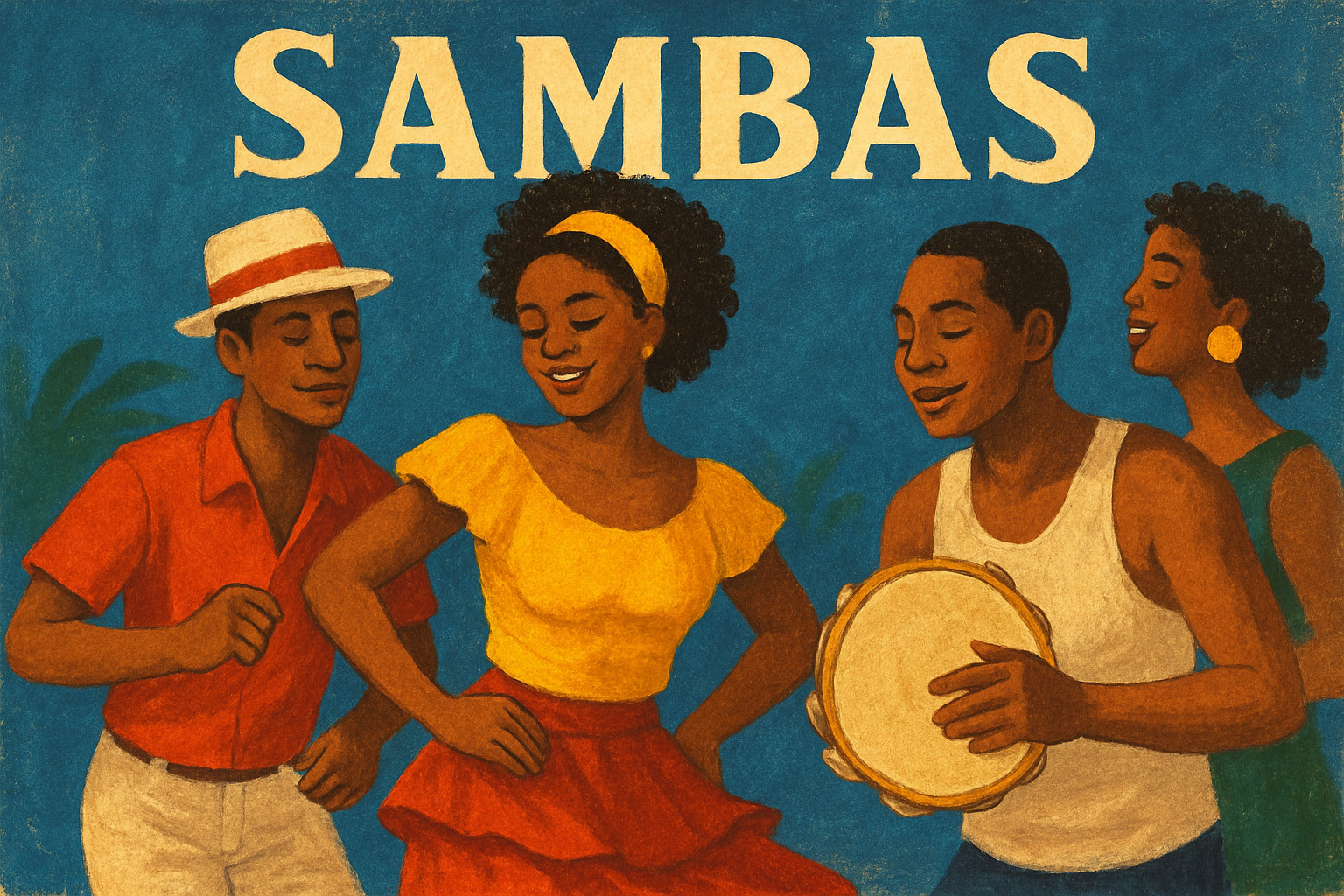
When you pick up a pair of Sambas, you’re holding a piece of design history. The classic model features a soft leather upper that gradually molds to your foot like a second skin. The iconic suede T-toe overlay reinforces the area that takes the most abuse during indoor sports. And that honey-colored gum rubber outsole offers exceptional grip while becoming the shoe’s visual signature.
The famous three stripes aren’t mere decoration either. Originally, they provided structural support across the midfoot—form following function at its finest. Inside, a simple EVA insole provides just enough cushioning without lifting your foot too far from the ground.
Major Variants Explained
Over the years, the Samba family has grown to include several distinctive siblings:
The Samba OG stays truest to the original design, using premium materials and that classic suede T-toe that’s currently enjoying a massive fashion renaissance.
For actual soccer play, many prefer the Samba Classic with its additional padding and slightly more robust construction.
Skateboarders gravitated so naturally to Sambas that Adidas eventually created the Samba ADV, adding a TPU heel clip for stability during tricks and beefing up durability in high-wear areas.
City cyclists fell in love with the Velosamba, which cleverly integrates a two-bolt cleat system for standard cycling pedals while maintaining a look that doesn’t scream “bike shoe” when you’re off the saddle.
Fashion-forward folks might opt for the Sambarose with its lifted platform sole—a contemporary twist that’s especially popular in women’s sizing.
For the environmentally conscious, newer Samba models feature vegan uppers crafted from plant-based materials and incorporate recycled components.
Sambas Key Features & Materials
What makes Sambas stand out in a crowded sneaker market is their thoughtful balance between form and function:
The shoe’s thin profile keeps you close to the ground, offering exceptional stability and control. The non-marking gum rubber outsole won’t scuff up indoor courts or dance floors, which helped cement the Samba’s reputation in indoor soccer circles.
Despite their durability, Sambas remain surprisingly lightweight at under 12 ounces per shoe. The reinforced toe area and quality materials contribute to their legendary longevity—many wearers report their Sambas lasting for years of regular use.
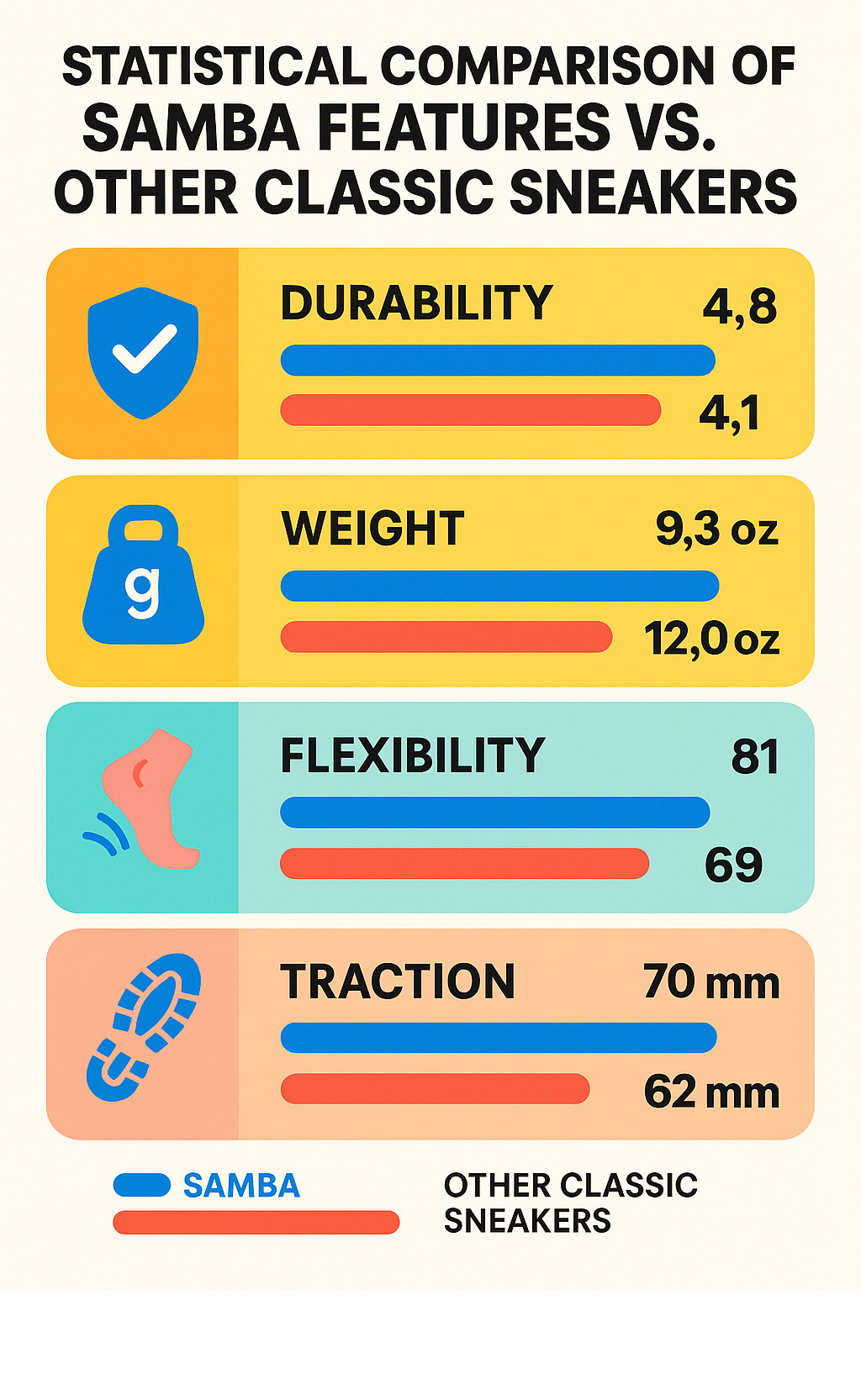
The enduring appeal of the Samba lies in its beautiful simplicity—it includes only what’s necessary, with each element serving both aesthetic and functional purposes.
Fit, Comfort & Performance
If you’re considering adding a pair of Sambas to your collection, understanding their unique fit and feel is essential. These iconic sneakers have a distinctively narrow profile, especially in the toe box—a design choice rooted in their soccer heritage where a snug fit helps with ball control. For many wearers, this creates a secure, almost glove-like fit that actually improves over time as the leather upper gradually molds to your foot’s unique shape.
That said, the narrower design means those with wider feet might want to size up by half a size. While the leather will eventually stretch and conform, there’s no need to suffer through an uncomfortable break-in period if you can avoid it with proper sizing from the start.
When it comes to cushioning, Sambas take a minimalist approach. The thin EVA insole provides just enough protection without the excessive padding found in many modern sneakers. This design philosophy shares more in common with barefoot-inspired footwear than heavily cushioned athletic shoes—you’ll feel more connected to the ground beneath you.
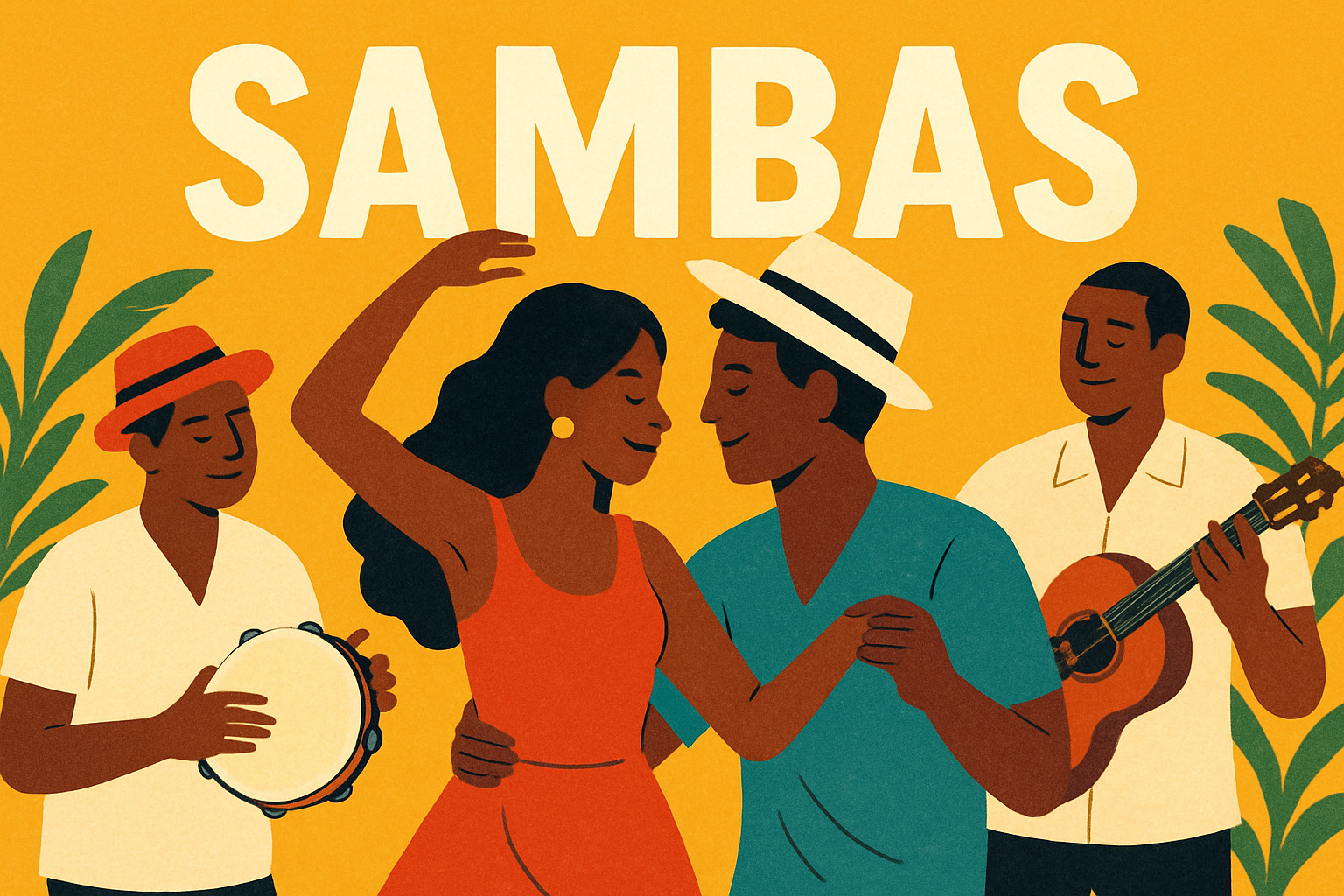
Sizing Guide for Sambas
Finding your perfect fit in Sambas might take a little extra attention, but it’s worth the effort:
For women shopping men’s styles (which offer the widest selection), go down 1-1.5 sizes from your usual size. As a rule of thumb, a women’s US 8 typically translates to a men’s US 6.5 or 7.
The narrow fit means many people benefit from going up half a size from their usual measurement, especially if you have wider feet or plan to wear thicker socks. The good news is that Sambas feature a removable insole, making them compatible with custom orthotics.
Be prepared for a brief 1-2 week break-in period as the leather softens and conforms to your feet. During this initial phase, wearing slightly thicker socks can help gently stretch the leather for a more personalized fit.
Are Sambas Good for Running & Sports?
While Sambas were born on the soccer field, their versatility across different activities varies considerably:
For soccer and futsal, these shoes are in their natural element. The non-marking gum sole provides excellent traction on indoor courts, while the low profile offers superior ball feel. The reinforced toe area stands up admirably to the demands of the beautiful game.
When it comes to running, however, Sambas wouldn’t be most trainers’ first recommendation. Their minimal cushioning and flat sole lack the impact protection and energy return that purpose-built running shoes provide. That said, some minimalist running enthusiasts enjoy using them for shorter distances, particularly on forgiving surfaces like grass fields or soft trails.
For cycling enthusiasts, the specialized Velosamba variant offers a brilliant compromise between performance and style. With a stiffer sole and compatibility with standard two-bolt cycling cleats, they’re perfect for urban cyclists who want functional shoes that don’t scream “cyclist” when they’re off the bike.
Skateboarding has acceptd Sambas since the 1990s, with the dedicated Samba ADV variant offering improved durability and board feel. Even the standard models have earned respect in skate culture thanks to their grippy gum soles and sturdy construction.
Where Sambas truly excel is in everyday wear. Their comfortable, low-profile design makes them ideal companions for walking, casual outings, and all-day comfort once properly broken in.
Looking to refresh other parts of your wardrobe as the seasons change? Check out our guide to seasonal product swaps for more inspiration.
Style & Culture: Why Sambas Remain an Icon
Few sneakers have maintained cultural relevance for over seven decades like Sambas have. Their enduring popularity isn’t just luck—it’s the perfect blend of clean design, influential cultural adoption, and remarkable versatility that lets them complement almost any casual outfit.
The journey of Sambas from sports fields to fashion streets tells a fascinating story. Born on the football pitch, these humble shoes found their way into the heart of music scenes—especially in the UK’s post-punk and Britpop movements of the 1990s. Iconic moment in “Trainspotting” (1996)? Those Sambas on screen cemented their connection to youth culture and alternative music in a way few shoes ever achieve.
Fast forward to today, and Sambas are experiencing a massive renaissance. You’ll spot them on Kendall Jenner while grabbing coffee, on Emily Ratajkowski walking through SoHo, and even on political figures like UK Prime Minister Rishi Sunak (who famously apologized for wearing them—inadvertently highlighting just how culturally significant these sneakers have become).
What makes Sambas truly special is their trend-transcending quality. While they certainly have moments of heightened popularity, they never actually go out of style. Their clean lines and simple design allow them to adapt to changing fashion landscapes without ever looking dated.
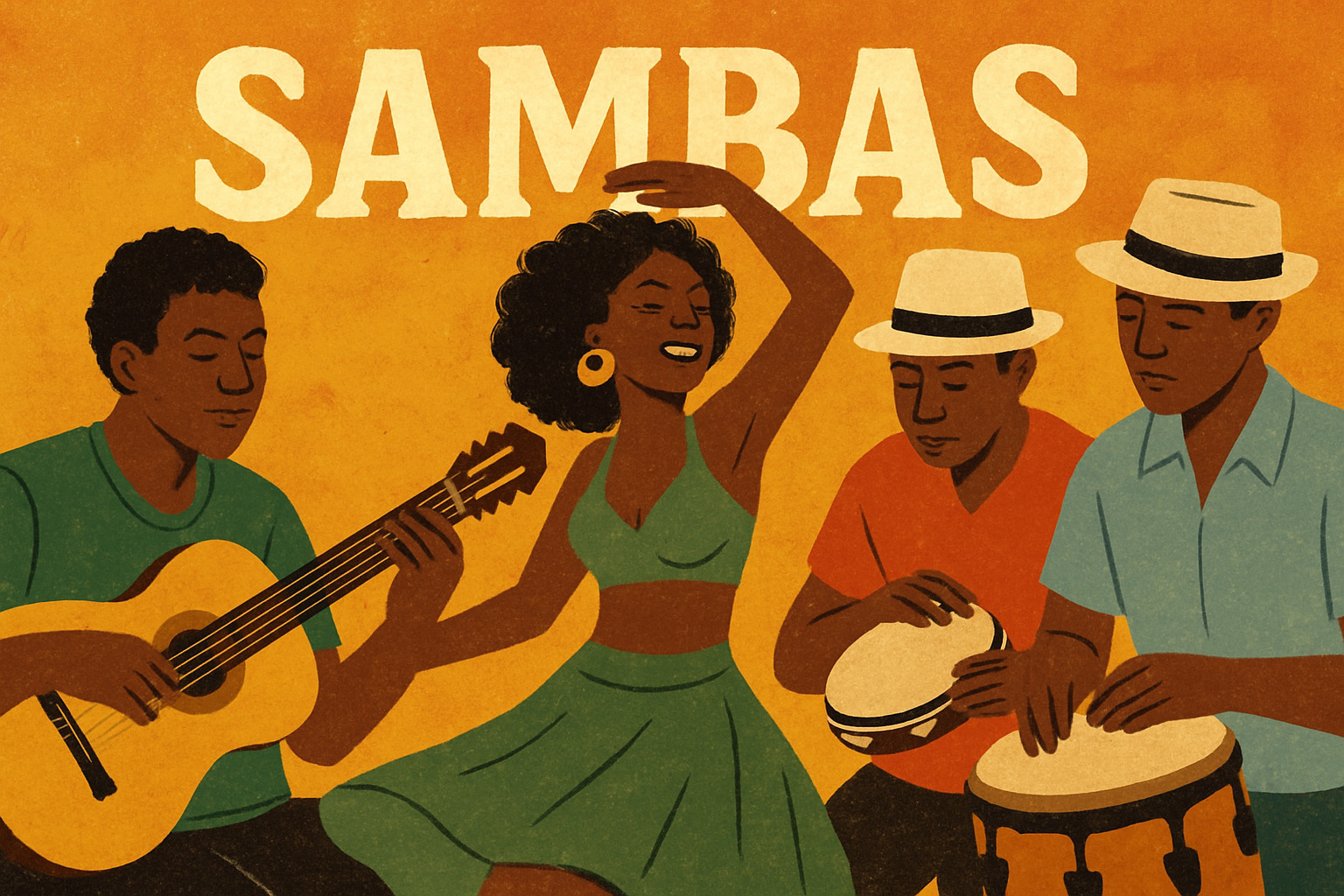
How to Style Sambas
The beauty of Sambas lies in their incredible versatility—they’re perhaps the most adaptable shoes in your closet.
With jeans, they create the most classic pairing imaginable. Try your Sambas with slim or straight-leg denim, either cuffed to show a bit of ankle or full-length. Both dark wash for a more polished look and light wash for casual vibes work beautifully with the iconic black/white or all-black colorways.
For a slightly more lifted look, pair your Sambas with chinos or custom trousers. There’s something effortlessly cool about the contrast between a casual sneaker and more formal pants—it creates that perfect smart-casual balance that works for so many occasions.
Ladies, don’t think Sambas are just for pants! They add a wonderful sporty edge to skirts and dresses. They’re particularly magic with midi skirts or casual dresses, creating a balanced silhouette that’s both comfortable and stylish without trying too hard.
Embracing the Samba’s athletic heritage? Pair them with athleisure—track pants, joggers, or leggings all honor the shoe’s sporty roots while keeping things contemporary and comfortable.
Don’t overlook your sock choice with Sambas. Their low profile works beautifully with no-show socks for a clean summer look, but they also pair wonderfully with statement crew socks when you want to make more of a style statement.
The real secret to styling Sambas is embracing their beautiful simplicity. They don’t scream for attention—instead, they complement your overall look with their understated cool. This makes them ideal for travel—versatile enough for multiple outfits while remaining comfortable for all-day exploration.
More info about casual summer outfits
Sambas in 2024 Sneaker Culture & Sustainability
In the ever-changing world of sneakers, Sambas stand apart as something special. Unlike many trendy releases that burn bright and quickly fade away, these classics have maintained steady popularity while enjoying periodic moments in the spotlight. The current revival, which kicked off around 2020, continues to gain momentum in 2024.
What makes the Sambas phenomenon so fascinating is how these shoes bring together different parts of sneaker culture. They appeal to history buffs who value their authentic heritage, fashion-forward shoppers drawn to designer collaborations, and environmentally conscious consumers looking for responsibly produced footwear.
The partnership with British-Jamaican designer Grace Wales Bonner has been nothing short of transformative. Her take on the classic silhouette reportedly boosted demand for the Samba OG by ten times! These special editions feature premium materials and thoughtful design adjustments that lift the shoe while preserving its essential character.
When it comes to the resale market, certain Sambas collaborations do command higher prices, though not at the extreme levels seen with some other sneaker models. This relative accessibility has helped maintain the shoe’s reputation as an inclusive style symbol rather than just another status item.
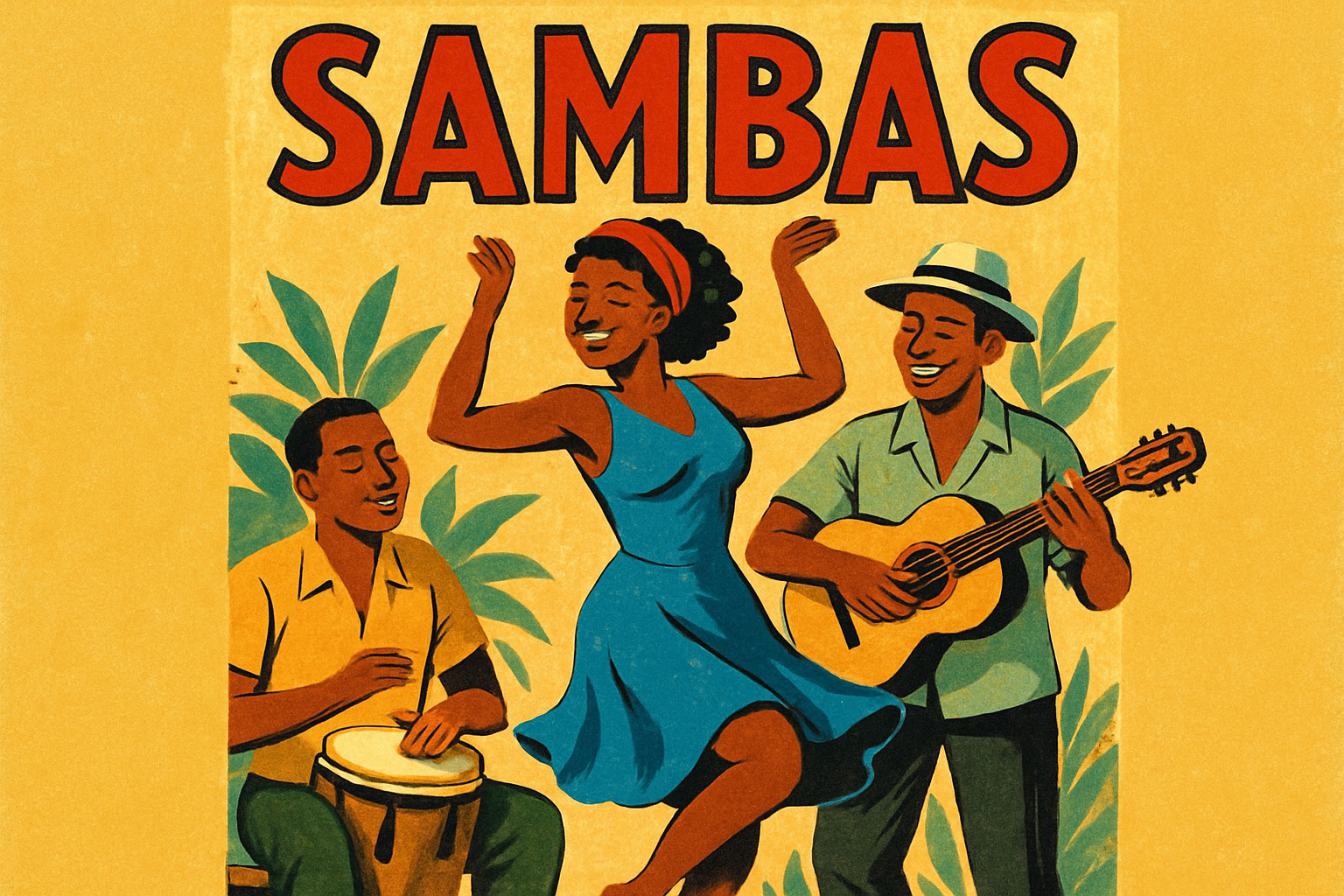
Perhaps the most exciting chapter in the Sambas story is the growing focus on sustainability. The newer models incorporate several eco-friendly innovations:
Vegan upper materials now offer plant-based alternatives to traditional leather that maintain the classic look and feel while reducing environmental impact. These materials have come a long way, with many wearers unable to tell the difference between these and traditional leather versions.
Recycled components have become increasingly common, with elements like the three stripes and lining materials now often made from recycled polyester. Water-based adhesives are replacing solvent-based options, reducing chemical usage and harmful emissions during manufacturing.
Some Samba-inspired models even accept barefoot shoe principles with ultra-thin, flexible soles that promote natural foot movement—a nod to both sustainability and foot health awareness.
This evolution toward more sustainable practices aligns perfectly with our values at Beyond Beauty Lab. We believe wellness extends beyond personal care to making environmentally conscious choices that benefit our planet. Just as we advocate for clean beauty products that are good for both your health and the environment, we appreciate footwear that balances style, function, and ecological responsibility.
Scientific research on eco-friendly materials
Frequently Asked Questions about Sambas
Why did Sambas shift from sports to lifestyle footwear?
The journey of Sambas from the soccer field to everyday streets wasn’t a calculated marketing move—it happened naturally over decades. Unlike many sports-to-street transitions we see today, Sambas earned their cultural status through genuine adoption.
The clean, unfussy design that made Sambas perfect for controlling a soccer ball also made them visually appealing for everyday wear. There’s something inherently versatile about their silhouette that just works with almost anything in your wardrobe.
The UK music scene played a huge role in this crossover. When post-punk and Britpop artists started wearing Sambas in the ’90s, they weren’t making a fashion statement—they were choosing affordable, comfortable shoes that happened to look great. The film “Trainspotting” cemented this connection, showing Sambas as part of authentic youth culture rather than manufactured trend.
What’s particularly charming about the Samba story is that Adidas initially just watched as people repurposed their sports shoes. Only later did they create lifestyle-specific variants while keeping the original sports models available.
How do Sambas compare to barefoot or minimalist shoes?
If you’ve been curious about barefoot or minimalist shoes but find their alien appearance off-putting, Sambas might be your perfect middle ground. While not designed as barefoot shoes, they share several important characteristics with the minimalist footwear philosophy.
Sambas feature a relatively thin sole that keeps you closer to the ground than chunky sneakers. They’re surprisingly flexible, allowing your foot to move more naturally than many modern shoes. The heel-to-toe drop is minimal—almost zero in most models—which promotes a more natural walking gait. And they’re wonderfully lightweight, avoiding that clunky feeling that comes with heavily structured shoes.
That said, Sambas aren’t true barefoot shoes. The toe box is narrower than dedicated barefoot models, which limits natural toe splay. They do include some cushioning via the EVA insole, and they maintain a traditional shoe structure rather than the glove-like fit of pure minimalist footwear.
Are there vegan or sustainable Samba options?
Good news for the environmentally and ethically conscious: Adidas has acceptd the sustainability movement with open arms, creating vegan Samba options that maintain the iconic look without animal products.
The Velosamba cycling shoe is a standout example, featuring a water-resistant vegan upper that performs brilliantly in all weather conditions. Beyond simply eliminating leather, Adidas has been incorporating recycled polyester into various components, implementing water-based adhesives and dyes, and improving manufacturing processes to reduce water and energy usage.
For those seeking the ultimate combination of sustainability and foot health, several independent brands offer Samba-inspired designs that pair vegan materials with true barefoot shoe principles like wide toe boxes and zero-drop soles.
At Beyond Beauty Lab, we’re particularly excited about this evolution toward more sustainable footwear options. Just as we believe in clean beauty products that benefit both personal health and the planet, we appreciate shoes that balance style, function, and environmental responsibility.
Conclusion
The enduring appeal of Sambas lies in their remarkable ability to balance function, style, and versatility. From humble beginnings on frozen football pitches to their current status as fashion icons, these sneakers have maintained their essential character while evolving to meet our changing needs and values.
What’s truly inspiring about the Samba story is how it shows that thoughtful design can transcend its original purpose. A shoe created to solve a specific athletic problem—traction on icy surfaces—has become a global style staple precisely because its design was rooted in genuine functionality rather than passing trends.
For travelers, Sambas offer the perfect combination of comfort and style. Their ability to pair with virtually any casual outfit makes them ideal for packing light without sacrificing options. Their durability ensures they’ll withstand the rigors of exploration, while their classic design means you’ll look appropriate whether visiting historic sites, enjoying local cuisine, or simply wandering city streets.
From a wellness perspective, the Samba’s evolution toward more sustainable materials aligns beautifully with a holistic approach to health. Their relatively minimalist design supports natural foot movement, while new vegan options reflect growing awareness of environmental impact. At Beyond Beauty Lab, we believe that making conscious choices about what we put on our bodies—from skincare products to footwear—contributes to overall wellness and self-care.
Whether you’re drawn to Sambas for their rich heritage, clean aesthetic, comfort, or sustainability initiatives, you’re participating in a design tradition that has proven its worth across generations. In a world of constant change and fleeting trends, there’s something deeply satisfying about choosing a classic that continues to feel relevant and fresh after more than 70 years.
For more insights on beauty, wellness, and conscious consumer choices, explore our resources at Beyond Beauty Lab.

